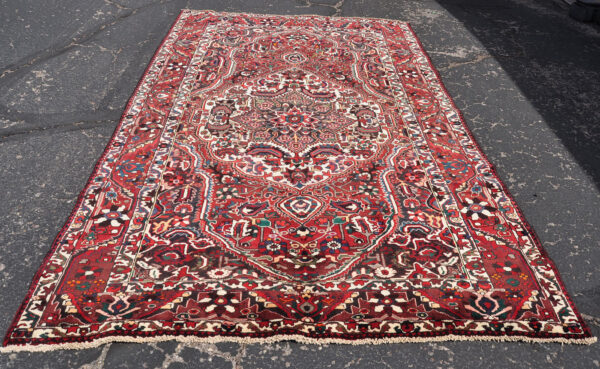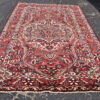Description
Large beautiful vintage Persian Heriz motif carpet from Persia in excellent overall condition. Fairly thick natural wool pile.
This rug was handwoven by the Bakhtiari tribe in western Iran. It is a Heriz motif but woven farther south, which is indicated by the different dye color palette and weaving techniques.
There are almost no signs of any wear on the wool pile. The weaver has woven the medallion in an asymmetric shape, playfully more like an egg. Consider this if you want exact symmetry from one end of the rug to the other.
Fringes and side cords are in great condition. No holes or any remotely weakened areas in the rug.
It can be used in a high foot traffic area or under a table and chairs.
Natural wool woven onto natural cotton. Last photo with Morgan silver dollar shows the back of the rug.
Main colors are brick red, white, salmon, gray, brown, blue, green, navy blue, black, and gold.
Exact size is 11 ft. 1 in. by 6 ft. 8 in. 1970s.
The Heriz or Serapi medallion design is one of the most popular in the world, and originated in the northwest of Persia. This motif favors a large central medallion and a wide elegant border.
Bakhtiari weavers often use a Heriz or serapi style medallion in their rugs. This large carpet was most likely woven in the Chaharmahal Province of central-western Iran.
The Bakhtiari tribe, numbering 800,000, inhabit an area of 67,000 sq. km that straddles the central Zagros Mountains in Iran. Although only about a third of the tribe is nomadic (the rest are settled agriculturists), the nomads embody the Bakhtiari cultural ideals.
They specialize in producing meat and dairy products and migrate seasonally with their sheep, cattle, or goat herds from high plateau pastures, where they spend the summer, west of the city of Esfahan, to lowland plains in the province of Khuzistan for winter herd grazing.
Their migration is among the most spectacular known among nomadic paternalists anywhere. They cross mountain passes at about 3,050 m. and therefore have to time their movement with extreme care in order to minimize the danger of early snowfall, flooding mountain rivers, and lack of grazing for their animals and flocks.
Shipping will be $69 within the continental U.S. Or free pickup in Tucson, AZ.
Please email me with questions. Thank you.
(BA0181 O221)





